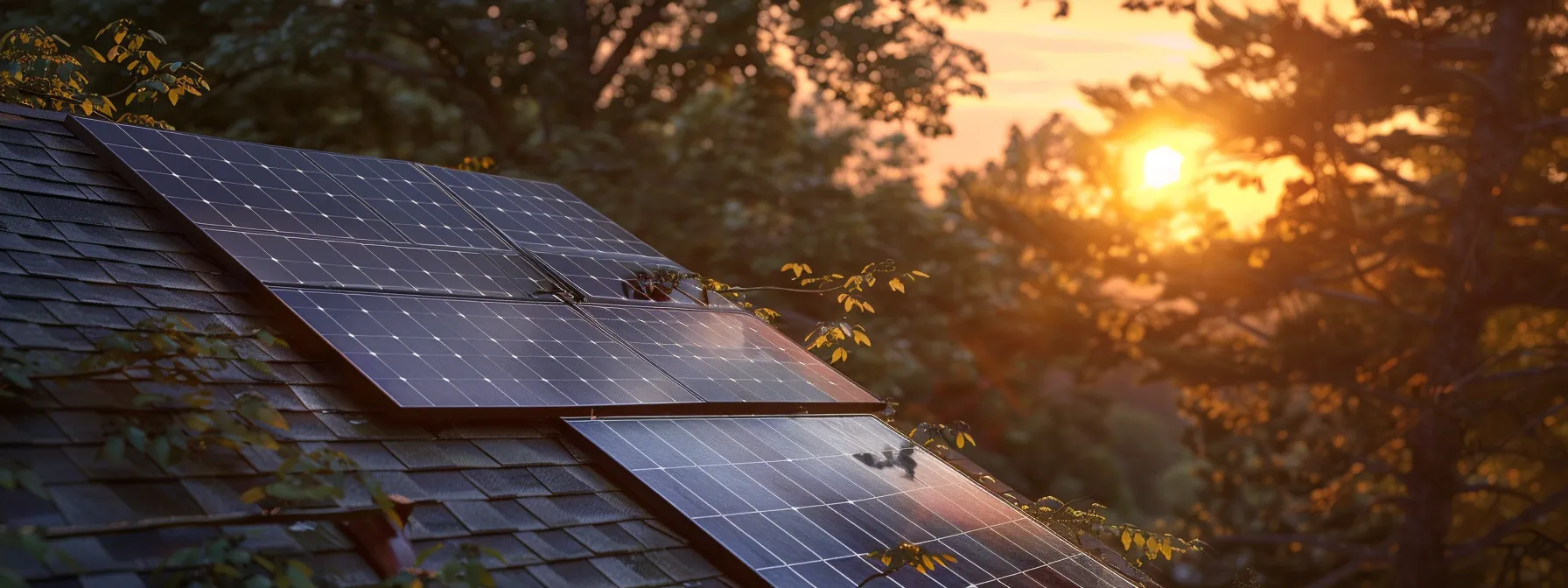Choosing the right solar panel system is crucial for anyone looking to reduce their carbon footprint and save on energy costs. Many customers are confused about what to consider when installing solar panels, from understanding their energy needs to selecting the appropriate technology like amorphous silicon panels. This article will cover essential topics such as assessing your property for installation, analyzing costs and financial incentives, and selecting a trusted provider. By addressing these key points, readers will gain valuable insights to make informed decisions that align with their energy system goals.
Key Takeaways
- measuring current electricity usage establishes a baseline for selecting the right solar panel system
- forecasting future energy needs optimizes the sizing of solar panel systems effectively
- proper roof inspection ensures solar panels are installed securely and can maximize sunlight exposure
- understanding warranty coverage and maintenance needs protects the investment in solar energy systems
- selecting a reputable provider ensures reliable installation and long-term performance of solar panel systems
Determine Your Energy Needs for the Ideal Solar Panel System

Understanding energy needs is crucial when selecting the ideal solar panel system. First, measuring current electricity usage provides a baseline for energy consumption. Next, forecasting future energy requirements helps anticipate growth or changes in usage. Lastly, calculating the required system size ensures the installation will efficiently meet energy demands Sell Solar. These steps are vital for buying solar panels that maximize efficiency and savings.
Measure Your Current Electricity Usage
Measuring current electricity usage is a foundational step in selecting the ideal solar panel system. Homeowners and businesses should review their past electricity bills to determine energy consumption over a typical year, calculated in kilowatt-hours (kWh). This measurement acts as the baseline for understanding the solar panel cost and helps in designing a system that aligns with their sustainable energy needs.
In addition to reviewing past usage, employing a smart metre can provide real-time data on the electricity consumption. This allows users to pinpoint peak usage times and identify energy-intensive appliances. Understanding these patterns is essential when choosing a solar energy solution that utilizes efficient technologies like monocrystalline silicon panels, which can optimize production and ultimately lower the overall cost of energy solutions.
Forecast Future Energy Consumption
Forecasting future energy consumption is essential for selecting the right solar panel system. By understanding potential increases in energy needs, such as electric vehicle charging or appliance upgrades, homeowners and businesses can size their Sell Solar systems accordingly. This proactive approach not only optimizes the return on investment but also reduces greenhouse gas emissions by ensuring sufficient energy generation without reliance on the electrical grid.
Utilizing energy management strategies like Finance Options can further refine these projections. For instance, implementing smart technology to monitor and control energy usage can help identify trends and adjustments over time. This insight allows for a more accurate assessment of future energy needs, which is critical for maximizing the efficiency of solar cells and minimizing energy costs in the long term.
Calculate the Required System Size
Calculating the required system size for rooftop solar panels involves assessing the total energy needs based on both current and future consumption. Experts recommend considering sunlight exposure, as this directly impacts solar panel efficiency. By analyzing local sunlight patterns throughout the year, homeowners and businesses can better estimate the number of panels needed to achieve energy independence, ensuring that the system meets all their energy requirements effectively.
Additionally, utilizing advanced technology can facilitate accurate calculations for system size. Innovation in solar energy analysis tools can assist users in determining how much energy their rooftop solar panels will produce based on their specific location and energy consumption patterns. This proactive approach allows users to make informed decisions that optimize solar energy production and reduce reliance on traditional energy sources, paving the way for a more sustainable future:
- Measure current electricity usage
- Forecast future energy consumption
- Calculate required system size based on sunlight availability
- Utilize technology for precise energy projections
Now that the energy needs are clear, it’s time to explore the different solar panel types available. Choosing the right panel will shape your solar journey and impact your savings.
Choose the Optimal Solar Panel Type for Your System

Selecting the optimal solar panel type is crucial for maximizing energy efficiency and long-term performance. This section will compare monocrystalline and polycrystalline panels, focusing on their efficiency and performance metrics. It will also assess longevity and reliability, ensuring that users understand how each brand impacts overall system effectiveness. Additionally, insights on recycling options and potential tax credits will be discussed to ensure a comprehensive understanding of investment benefits.
Compare Monocrystalline and Polycrystalline Panels
Monocrystalline panels are widely recognized for their high efficiency and sleek appearance, making them a popular choice for residential and commercial solar energy systems. With efficiency ratings often exceeding 20%, these photovoltaics are ideal for those looking to maximize their energy output in limited space. Additionally, they typically come with longer warranty periods compared to polycrystalline panels, offering peace of mind for users committed to net metering systems that require reliable energy generation.
On the other hand, polycrystalline panels represent a cost-effective alternative, often chosen for larger installations where budget is a primary concern. While they generally have slightly lower efficiency ratings, around 15-17%, they still provide solid performance. This makes them a suitable option for projects that integrate components like solar inverters and lithium iron phosphate battery systems, allowing users to store solar energy effectively while balancing installation costs:
- Assess panel efficiency and aesthetics
- Evaluate cost-effectiveness for larger projects
- Consider warranties that support long-term investments
- Integrate solar inverters for optimal energy use
- Explore options for energy storage with lithium iron phosphate batteries
Review Efficiency and Performance
Efficiency and performance in solar panels are directly influenced by their surface area and design. Higher efficiency ratings, which indicate the percentage of sunlight converted into usable electricity, are crucial for optimizing energy output, particularly in properties with limited roof space. For instance, choosing high-efficiency monocrystalline panels can maximize energy production while minimizing the physical footprint, making them especially suitable for urban installations.
Longevity is another vital aspect to consider when selecting solar panels, as it impacts the system’s overall return on investment. Panels that maintain high efficiency over many years contribute to reducing greenhouse gas emissions more effectively, strengthening their role as a reliable source of renewable energy. Understanding the long-term performance of different panel types ensures that homeowners and businesses make informed decisions that align with their sustainability goals:
- Assess panel efficiency based on surface area
- Consider the longevity of solar panels
- Evaluate the potential greenhouse gas reduction
- Maximize renewable energy generation in limited spaces
Assess Longevity and Reliability
Assessing the longevity and reliability of solar panels is essential for sustainable living. Products with high durability typically come with comprehensive warranties that reflect their expected lifespan. For instance, Tesla solar panels are engineered to withstand diverse environmental conditions, ensuring consistent performance over the years. Understanding the temperature coefficient of solar panels can further aid in selecting systems that maintain efficiency even under varied temperature conditions, making them a valuable resource for energy conservation.
In addition to evaluating warranties and temperature coefficients, it is vital to consider the materials used in manufacturing solar panels. High-quality panels demonstrate resilience against weather-related impacts, reducing the need for repairs or replacements. This focus on durability not only supports long-term investment return but also contributes to a reduced carbon footprint, aligning consumers with their goals of sustainable living while maximizing energy production from their solar systems.
Choosing the right solar panel type sets the stage for success. Next, it’s time to examine your property and see how it can support your new energy system.
Assess Your Property for Solar Panel Installation

Assessing a property for solar panel installation involves several critical factors. First, inspecting the roof‘s condition and suitability is vital to ensure it can support solar panels. Identifying the best location for maximum sunlight exposure will enhance solar power production. Lastly, it’s essential to address potential shading issues from trees or buildings, as these can impact energy consumption and overall utility efficiency.
Inspect Your Roof‘s Condition and Suitability
Inspecting the roof‘s condition is a critical step when considering solar panel installation. A sturdy, well-maintained roof provides the best foundation for supporting a photovoltaic system. Homeowners need to ensure that their roof is free from damage and able to withstand the additional weight of solar panels, which can impact their decision to buy solar panels. An in-depth assessment will help identify any necessary repairs or reinforcements that must be addressed before proceeding.
The suitability of the roof‘s angle also plays a significant role in the efficiency of solar panel systems. Ideally, roofs that are angled directly towards the sun can enhance energy capture and optimize the energy footprint of the installation. Homeowners should pay attention to any potential shading from nearby structures or trees that might hinder overall energy production and should consult with solar professionals to determine the best location for panel placement:
- Inspect the roof for damage and suitability
- Evaluate the roof’s angle for optimal sunlight exposure
- Check for shading issues from trees or nearby buildings
- Consider necessary repairs or reinforcements
Identify the Best Location for Maximum Sunlight
Identifying the best location for solar panel installation is essential for optimizing energy capture from sunlight. This requires assessing the roof‘s orientation and angle, ensuring it receives ample sunlight throughout the day. Homeowners should consider not only the roof‘s current condition but also the solar panel brand‘s recommendations based on the country of origin, as different brands have distinct performance metrics related to sunlight exposure.
To maximize sunlight exposure, it is vital to evaluate any potential shading from nearby structures or trees that could obstruct sunlight. Understanding these factors will enable homeowners to make informed decisions that enhance the overall efficiency of their solar systems. Proper knowledge of sunlight patterns, coupled with the careful choice of installation location, can lead to significant energy savings and a greater return on investment.
Address Potential Shading Issues
Addressing potential shading issues is critical when planning a home solar system installation. Shading can significantly reduce the efficiency of solar panels, impacting overall energy production and, ultimately, the return on investment. Homeowners should carefully evaluate their property for any obstructions, such as trees or nearby buildings, that may create shade, especially during peak sunlight hours. Consulting with solar professionals can help ensure that the system design accounts for these factors, maximizing energy generation and minimizing dependence on external power sources.
Moreover, one effective solution to mitigate shading risks includes integrating a solar battery into the system. By utilizing a solar battery, homeowners can store excess energy produced during sunlight hours, providing backup power during low production periods caused by shading or inclement weather, such as wind or clouds. Additionally, being aware of available subsidies can enhance the financial feasibility of implementing solutions to address shading issues, further strengthening the system’s reputation and performance. This proactive approach fosters long-term energy savings and a more sustainable lifestyle.
Once the property is ready, it’s time to uncover the financial picture. The next step reveals costs and potential rewards waiting for those who invest in solar energy.
Analyze Costs and Explore Financial Incentives

Analyzing costs and exploring financial incentives is crucial in selecting the ideal solar panel system. Consumers must break down the initial investment and assess the payback period to understand the financial commitment. Identifying available tax credits and rebates can significantly reduce overall costs, while considering financing and leasing options provides flexibility. These factors not only mitigate financial risk but also enhance energy efficiency and support lower carbon footprints.
Break Down Initial Investment and Payback Period
Breaking down the initial investment for solar panel installation involves examining the cost of the panels themselves, installation expenses, and potential add-ons like solar batteries for energy storage. The choice of crystalline silicon panels can influence overall costs; while they may be pricier upfront, their efficiency often leads to long-term savings. Understanding these costs, alongside estimating the return on investment, helps homeowners gauge the financial commitment needed to transition to an environmentally friendly energy source.
The payback period represents the time required for savings on energy bills to equal the upfront investment in solar technology. This period can vary based on factors such as local electricity rates and available incentives. Homeowners should explore options like financing or leasing arrangements to make the process more manageable. These strategies not only promote energy independence through the installation of solar panels but also support a shift towards more sustainable energy solutions, benefiting both personal finances and the environment.
Identify Available Tax Credits and Rebates
Identifying available tax credits and rebates can significantly lower the costs associated with installing home solar panels. Federal tax credits, such as the Investment Tax Credit (ITC), allow homeowners to deduct a substantial percentage of their solar investment from their federal tax liability. This incentive supports the transition to solar energy systems, promoting sustainability while providing financial relief as users invest in renewable technologies that counteract climate change.
Additionally, many states and local governments offer their own tax rebates, which can further enhance the affordability of solar cell installations. These regional incentives may vary significantly, so conducting thorough research is essential for maximizing financial benefits. By taking advantage of these tax credits and rebates, individuals can offset the initial investment and enjoy long-term savings on electric bills, all while contributing to a cleaner voltage generation process that reduces reliance on fossil fuels.
Consider Financing and Leasing Options
Considering financing and leasing options is essential for anyone looking to install a solar panel system. These flexible payment strategies help simplify the initial investment, enabling homeowners to manage costs effectively while taking advantage of available financial incentives. By choosing financing, individuals can own their solar system outright, benefiting from energy storage solutions that offer reliable backup power and long-term savings on utility bills.
Leasing options present an alternative for those who prefer lower upfront costs, allowing users to enjoy solar energy without the burden of full ownership. While leased systems typically come with a predetermined power rating, they still facilitate immediate savings on electricity bills. This approach ensures users can aid their sustainability goals while navigating the financial considerations of installing silicon-based solar panels, ultimately making renewable energy accessible to a broader audience.
Understanding costs and incentives lays the groundwork for smart choices. Next, finding a reliable provider can transform those decisions into reality.
Select a Trusted Solar Panel System Provider

Selecting a trusted solar panel system provider is essential for ensuring a successful installation and long-term satisfaction. Researching a company’s experience and reputation allows consumers to gauge reliability and performance. Reading customer reviews and testimonials offers insights into user experiences, while confirming licenses and certifications verifies compliance with industry standards. These considerations ultimately impact the price, policy, and life expectancy of solar panels, guiding owners toward informed decisions.
Research Company Experience and Reputation
When selecting a trusted solar panel system provider, researching the company’s experience and reputation is essential. A reputable provider specializing in residential solar panel systems should have a proven track record and positive customer feedback. This ensures that the chosen company is well-equipped to navigate the complexities of electrical energy production and can effectively address modern demands, such as integrating demand response technologies to improve energy efficiency.
In addition to customer reviews, examining the company’s involvement in climate change initiatives can provide valuable insights into its commitment to sustainability. Providers that focus on high-quality products, such as crystal solar panels, demonstrate a dedication to maximizing energy output while minimizing environmental impact. This kind of informed choice contributes not only to individual energy savings but also supports broader environmental goals, fostering a cleaner future for all.
Read Customer Reviews and Testimonials
Reading customer reviews and testimonials is a vital step for homeowners considering a solar panel system. These insights provide real-world experiences from individuals who have already navigated the complexities of solar installation and can highlight critical aspects such as long-term performance, payback periods, and the effectiveness of energy storage systems. Positive feedback can reassure potential buyers that they are making a wise investment in renewable energy, while negative reviews can offer valuable lessons on specifications to avoid or improvements to expect.
By focusing on customer feedback, homeowners can identify reputable providers who prioritize quality and service. For instance, testimonials that discuss receiving rebates or incentives highlight the financial benefits of choosing the right system. This information not only assists in selecting a dependable solar company but also enhances overall satisfaction with the installation process and system performance:
- Evaluate customer feedback on installation quality.
- Observe comments about payback period expectations.
- Research experiences related to energy storage systems.
- Look for mentions of available rebates and incentives.
- Consider overall satisfaction ratings and reliability issues.
Confirm Licenses and Certifications
Confirming the licenses and certifications of a solar panel system provider is essential for ensuring compliance with industry standards. Licensed companies demonstrate adherence to local and national regulations, which protects homeowners and businesses from potential liabilities. Providers with relevant certifications, such as those acknowledging their expertise in solar technology, convey credibility and reliability, giving customers peace of mind in their investment.
Moreover, selecting a provider with proper licensing can enhance the financing options available for solar installations. Companies that are licensed often qualify for various incentives and credits, which can make transitioning to solar energy more affordable. When evaluating potential providers, customers should ensure they verify licenses and explore options on the SolarAI Home Page for additional resources:
- Check licenses for compliance with regulations
- Look for certifications in solar technology expertise
- Consider the impact on financing options for installations
- Research potential incentives available through licensed providers
Finding the right solar panel provider is just the start. Next, delving into warranties and maintenance commitments reveals how to protect that investment for years to come.
Understand Warranties and Maintenance Commitments

Understanding warranties and maintenance commitments is essential when selecting the perfect solar panel system. This section will examine warranty coverage for both panels and inverters, ensuring users are aware of their protections. Additionally, planning for routine maintenance needs will help sustain optimal performance. Lastly, learning about after-sales support and service ensures ongoing assistance throughout the system’s life cycle.
Examine Warranty Coverage for Panels and Inverters
Examining warranty coverage for solar panels and inverters is essential for homeowners and businesses looking to protect their investment. Most manufacturers offer warranties that range from 10 to 25 years, ensuring both the performance of the solar panels and the functionality of the inverters are maintained. Understanding these coverage details is crucial, as they provide peace of mind, confirming that the system will continue to produce renewable energy efficiently over time.
In addition to evaluating the warranty duration, it is vital to assess the scope of coverage. Some warranties cover only manufacturing defects, while others may include performance guarantees that ensure the panels produce a specific percentage of their rated power. This knowledge empowers consumers to make informed decisions, as a robust warranty plays a significant role in long-term energy savings and system reliability.
Plan for Routine Maintenance Needs
Planning for routine maintenance needs is essential to ensure that solar panels operate at peak efficiency throughout their lifespan. Regular inspections can identify issues early, preventing costly repairs and ensuring that the system continues to meet energy demands effectively. Homeowners and businesses should be aware of the manufacturer’s recommendations for maintenance schedules, as these guidelines help in sustaining optimal performance and prolonging the life of the solar energy system.
Additionally, routine maintenance can often include cleaning the panels to remove dirt, debris, or snow that might obstruct sunlight and impede energy production. Recognizing the importance of maintaining optimal conditions for solar panels not only maximizes energy generation but also enhances overall return on investment. Engaging professional services for routine checks or cleaning helps users focus on reaping the benefits of their investment while ensuring their solar panels function efficiently year-round.
Learn About After-Sales Support and Service
After-sales support and service play a critical role in maintaining the efficiency and longevity of solar panel systems. Ensuring continuous assistance after installation helps homeowners address issues promptly, minimizing disruption and optimizing energy production. A reliable provider not only responds to inquiries but also offers troubleshooting support for any operational concerns that may arise.
Furthermore, ongoing maintenance recommendations from the provider can enhance the functionality of solar panels over time. Clear guidelines for inspections and performance checks empower users to proactively manage their systems. By understanding the available after-sales support options, consumers are better equipped to make informed decisions and maximize their investment in renewable energy:
- Understand the importance of responsive support after installation.
- Seek providers offering comprehensive troubleshooting options.
- Follow maintenance recommendations for optimal performance.
Conclusion
Selecting the perfect solar panel system is crucial for maximizing energy efficiency and ensuring a sustainable energy future. By carefully measuring current and future energy needs, choosing the right panel type, and assessing property suitability, homeowners and businesses can make informed decisions that enhance both performance and savings. Understanding warranties, maintenance commitments, and financial incentives further solidifies the choice, ultimately supporting long-term investment and environmental goals. Prioritizing these key considerations empowers consumers to navigate the solar landscape confidently, paving the way for a more sustainable lifestyle.



